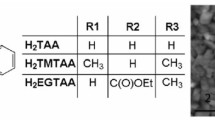Abstract
Chemical sensors can also be used for process control since they are able to follow concentration changes nearly instantaneously. The mass sensitive quartz-micro-balance (QMB), coated with cross-linked cyclodextrin cavities was applied to monitor the formation of the Grignard reagent. It was possible to detect the reactant chlorobenzene even in a saturated diethyl ether atmosphere down to some ppm (μL/L). This is equivalent to a molar ratio of 50000:1 of diethyl ether to chlorobenzene. The sensor characteristic is completely linear in the concentration range from 10 to 500 ppm (μL/L) chlorobenzene. As a practical application, the end point of the Grignard reaction can be determined in an accuracy of approximately 2% of the reagent supply. This was achieved by a direct on-line acquisition of the QMB frequency response or its derivative.
Similar content being viewed by others
Author information
Authors and Affiliations
Additional information
Received: 7 January 1998 / Accepted: 1 February 1998
Rights and permissions
About this article
Cite this article
Dickert, F., Tortschanoff, M., Weber, K. et al. Process control with mass-sensitive chemical sensors – Cyclodextrine modified polymers as coatings. Fresenius J Anal Chem 362, 21–24 (1998). https://doi.org/10.1007/s002160051030
Issue Date:
DOI: https://doi.org/10.1007/s002160051030




